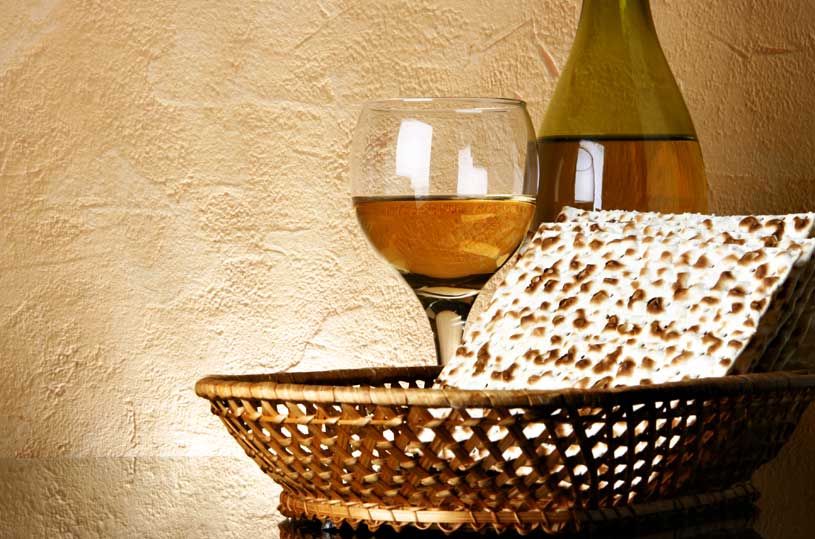
Kiddush should be made as soon as possible after nightfall so that the children will be able to stay up and hear the haggadah, since the whole purpose of the haggadah is to tell them the story of Yetzias Mitzrayim.
Four Cups of Wine
It is a mitzvah to use high quality red wine, but one fulfills his obligation with any type of wine, even of low quality or white. If someone finds it difficult to drink wine, or is concerned that he won’t be able to focus on the haggadah because of the alcohol, he should mix his wine with grape juice. If it is very difficult to drink wine, a person may drink grape juice by itself.
The cup used for the four cups of wine should contain at least a revi’is, which is 86ml. Ideally one should drink all the wine in the cup, but at the very least one must drink a cheek full – rov revi’is. If the cup contains more than a revi’is it is still ideal to drink the entire cup, or at least to drink most of the cup. Children who have reached the age of chinuch should also drink four cups, and for them it is enough to drink a cheek full. (Since their cheeks are smaller than adult’s cheeks, this amount is less than a rov revi’is. Rov revi’is is the amount of an average adult’s cheek full.) Ideally one should drink the entire cup in one go, pausing just to breathe or swallow. If this is very difficult, bedieved if one drank the required amount within 4 (or up to 7) minutes, he has fulfilled his obligation.
One is required to drink the wine and eat the matzos on Seder night while leaning, as do free men. One should lean to his left, even a left-handed person. The Ashkenazi minhag is that women do not lean, but Sefardi women do lean. Women are required to drink the four cups, as well as to tell the story of Yetzias Mitzrayim. If a woman does not understand the language used in the haggadah, one must explain the story to her in a language she does understand.
Matzah
After the brachos of המוציא and על אכילת מצה one ideally needs to eat two kezeisim of matzah. One kezayis should be from the top matzah, on which the המוציא was made, and one kezayis from the middle matzah which had been broken – on which על אכילת מצה was said. After that another kezayis should be eaten for Korech together with maror, and at the end of the meal another kezayis is eaten from the Afikoman.
A kezayis is roughly a third of a hand-baked matzah, which means that after the brachos of המוציא and על אכילת מצה one needs to eat two thirds of a hand-baked matzah. For Korech one needs to take around a third of a hand-baked matzah, as well as another third for the Afikoman. This amount needs to be eaten within 4 (or up to 7) minutes – if it took longer, he has not fulfilled his obligation.
If one ate matzah without leaning has not fulfilled the mitzvah in the manner Chazal decreed, so he has to eat another kezayis, this time leaning of course. Even if he has already bentched, if he realizes that he did not lean while eating matzah he should wash his hands again, make המוציא and eat a kezayis while leaning. This time he should not make the brachah על אכילת מצה.
At the end of the meal a kezayis is eaten for the Afikoman. (Some say it is good to eat two kezeisim for the Afikoman.) If the half matzah that was hidden does not contain enough kezeisim for all present, each person should at least receive a little of the Afikoman matzah, and then add from other shmurah matzos to make up a kezayis. If there is not even enough to give everyone a small piece from the Afikoman, it is still acceptable to take other shmurah matzah and use it as the Afikoman. The Afikoman is supposed to be eaten while satisfied – but he should still want to eat more. However, if he is so full that he does not want to eat at all, he is not fulfilling the mitzvah of Afikoman correctly since he would rather not eat at all. If he is yet more full, to the extent that he can’t bear the thought of eating more, and he nevertheless forces himself to eat the Afikoman, he has not fulfilled his obligation. This is because such eating is called achilah gassa, which is not halachically considered eating.
After the Afikoman one should not eat anything, and ideally one should drink nothing except water, so that the taste of matzah remains in his mouth. Many Poskim allow one to drink coffee or juice, especially if one’s purpose in drinking the coffee is to enable him to stay up longer to think about or learn the halachos of Pesach and the story of Yetzias Mitzrayim.
